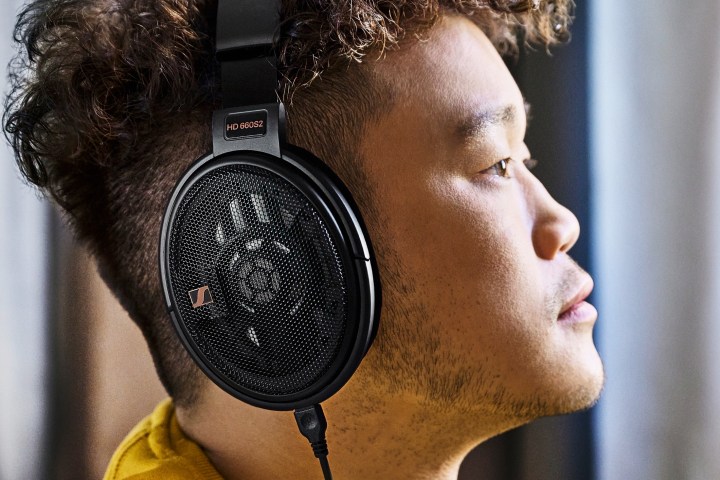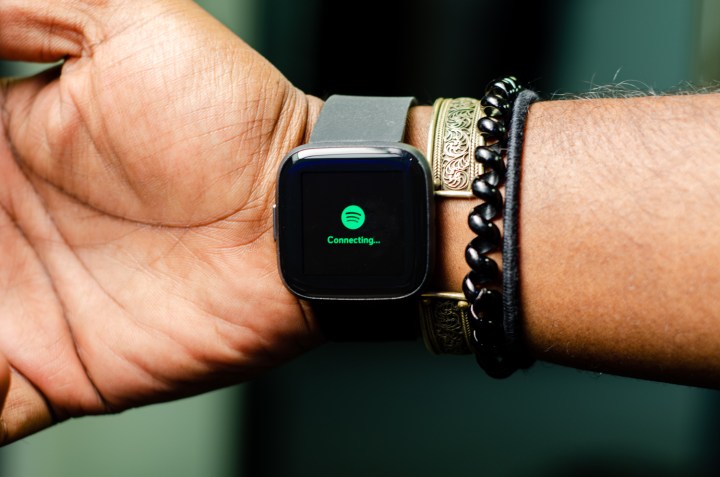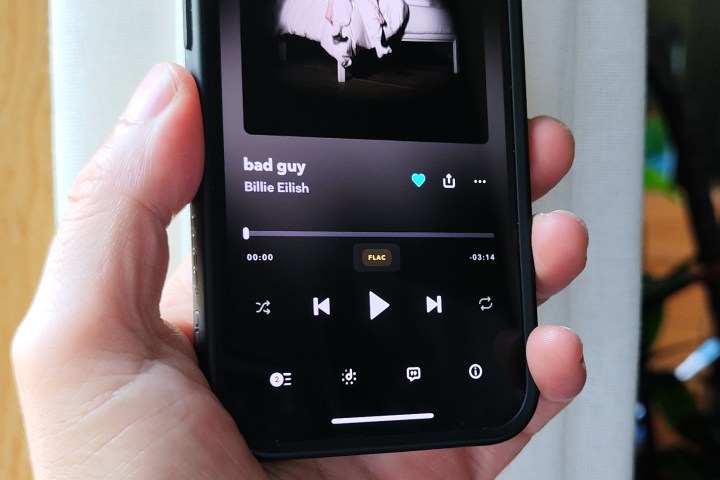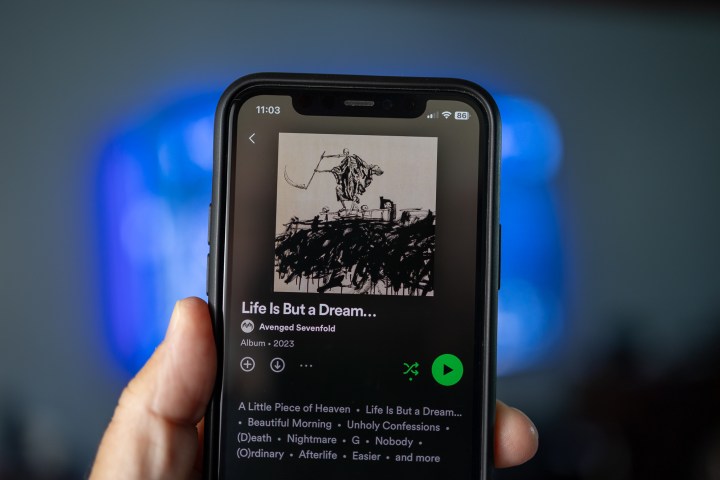Spotify has over 220 million subscribers and access to an immense library of artists, albums, podcasts, and audiobooks. A go-to music-streaming platform, Spotify is available on just about every desktop and mobile device one can think of. While it’s a phenomenal way to enjoy your favorite tunes, it’s certainly not the only music streamer in town. In fact, if you’re committed to listening to only the best-sounding audio, Tidal may be a better fit. With its emphasis on hi-res content, Tidal is also home to a giant archive of music and video content.
But is one of these music streaming platforms truly the better of the two? To find out, we compared Spotify and Tidal, focusing on criteria like price, sound quality, and supported devices.
Price

For individual users, Spotify has two tiers of service: The free, ad-supported tier which gives you access to the full library of Spotify content, but severely restricts how you can interact with it (not to mention the ads). Its full-featured Premium plan is $11 per month, which is pretty standard for the industry at the moment. Spotify also offers plans for two individuals for $15 per month, which it bills as Spotify Premium Duo. There’s also a student plan at just $6 per month and a six-person family plan (with parental controls) for $17 per month.
Students get a particularly good deal; a student Spotify premium plan entitles you to a free, ad-supported Hulu account, plus Showtime access too. If you’ve never signed up for Spotify before, you’ll be able to try Spotify Premium free for 30 days. All of its paid plans let you download up to 10,000 songs for offline listening on up to five different devices.
Similar to Spotify, Tidal also offers free listening with occasional ad interruptions and limited track skips. At the free level, track quality is also capped at 160kbps. The two best versions of Tidal are paywalled though, and these are the HiFi and HiFi Plus plans. The former is $11 per month and grants you full access to Tidal’s entire music and video catalog ad-free, including offline downloads and improved track quality (up to 16-bit 44.1kHz). You’ll also gain access to a few other cool features, like Live on Tidal for real-time shared listening with other Tidal subscribers, as well as expertly curated playlists.
If you want the best audio quality possible, you’ll want to sign up for Tidal’s HiFi Plus plan, which will run you $20 per month. At this level, you’ll be able to enjoy certain tracks at up to 24-bit 192kHz. Supported hi-res formats include HiRes FLAC, Dolby Atmos, FLAC, Sony 360 Reality Audio, and MQA (although things are changing with this format). All of the benefits of the HiFi plan are also rolled into the HiFi Plus tier.
Like Spotify, Tidal also offers a range of student, family, military, and first responder plans. Family pricing starts at $17 per month and covers up to six household members, while the student plan knocks 50 percent off the cost of a HiFi or HiFi Plus plan. There’s also a 40% discount offered for military and first responders.
Both HiFi and HiFi Plus plans are free for the first 30 days. With all of these pricing options in mind, we’re going to award a point to Spotify for its lower monthly cost.
Winner: Spotify
Supported devices

Tidal has apps for all the big platforms, including Windows, MacOS, iOS, tvOS, Android and Android TV. With an emphasis on the audiophile crowd, it also supports some very high-end streaming components from brands like Astell & Kern, Devialet, Denon, Harman Kardon, KEF, Martin Logan, and Meridian, to name a few. Its support for more common devices like game consoles or even the Roku platform is more anemic. Users who want to get Tidal streaming on these devices may need to sign up for a Plex account. You can add your Tidal account to Plex, and from there you can use the Plex client on a wide variety of media streamers and game consoles.
Spotify not only has the major platforms covered, but there are also very few connected audio devices that the service doesn’t support. From smart speakers to smartwatches, and even some of the audiophile brands that Tidal covers, Spotify’s device support is arguably the best among all of the music streaming services.
Winner: Spotify
Music variety and catalog size

This might be the toughest category to judge. As of October 2023, Tidal claims a 100 million track library, along with 650,000 videos. Spotify claims it has over 100 million tracks, plus 5 million podcasts and 350,000 audiobooks. We have yet to find an independent source that can verify these claims, so we’ll take them at their word for now.
Music variety can also be tricky to determine. The general sense is that Tidal’s catalog skews toward rap and hip-hop artists, especially young and relatively unknown ones. This is in keeping with Tidal’s ownership structure, which largely consists of successful musicians such as Jay-Z, who have an interest in promoting other talents. However, this perception may be biased through Tidal’s editorial and recommendation processes, both of which also tend to surface these genres more than others.
For its part, Spotify’s catalog appears to be more balanced, though again, this might be a reflection of how the service automatically starts to tune itself to listeners’ demonstrated musical interests. We do know that some artists have actively refused to let their music be carried by Spotify over concerns about inadequate royalty payments (most of which stem from its free, ad-supported tier). Taylor Swift famously boycotted the company in 2014, though she has since added some of her albums back.
With claimed catalog sizes that are among the biggest in the industry and no objective way to evaluate any of this, we’re calling this one a tie.
Winner: Draw
Sound quality

If it was difficult to assess the kind and amount of music on each service, determining sound quality is easy. Spotify’s compressed, 320kbps streaming quality sounds very good on most audio devices, and for casual listening or in locations with lots of competing noise, it’s probably more than adequate. Tidal’s free listening is essentially the same. But if your ears yearn for something better, it’s hard to beat Tidal’s HiFi Plus membership with its double-whammy of lossless, CD-quality streams for the entire catalog and its smaller but worthy catalog of hi-res tracks.
There is a small caveat here: To get the most out of Tidal’s higher bandwidth streams, you’ll need a compatible device and, in some cases, a DAC. Virtually all of Tidal’s supported devices can handle its lossless CD-quality streams. But mobile users, take note: These streams will eat up your allotment of data at a much faster rate (up to four times faster) than the free tier audio, and its hi-res tracks will gobble it up even faster.
Speaking of hi-res, Tidal delivers said tracks via formats like Dolby Atmos, Sony 360 Reality Audio, and MQA. Some Tidal devices will let you play MQA streams but limit the quality (Apple devices), while others can play MQA in its full, studio-quality depth. Here’s a handy list of all of the devices that work with MQA.
Winner: Tidal
Videos, podcasts, and more

These days, music streaming services are about more than just music. Videos, podcasts, interviews, and live concerts are all becoming important parts of the mix. Tidal has chosen to focus on videos and live concert recordings, some of which are exclusive to the service. It has a catalog of over 650,000 videos, some of which are portions of live concerts, live concerts in their entirety, or exclusive shows. For mobile users, the ability to download any of these videos for offline viewing is a big help for avoiding data charges.
Spotify has videos too, but the company appears to be coy when it comes to promoting them. You won’t find a video category when you browse, and even the search filtering options such as “see all artists” lack a “see all videos” item. What you actually have to do is search for a specific song or podcast, and then check to see if there’s a video attached to the stream. If there is, you’ll be able to press play and start watching it.
Some folks have also had issues accessing video content, even when it is available. If you’re trying to watch with the Spotify mobile app, you may have to go into the app settings and toggle off Audio Quality. For whatever reason, this seems to act as a remedy for missing videos.
As far as Spotify’s podcast content goes, the company boasts a catalog of over 5 million podcasts. Tidal had a grand total of 25 podcasts when we checked as of the publication of this article.
As impressed as we are by Tidal’s video catalog, you subscribe to a music streaming service primarily because of audio. With the huge increase in the popularity of podcast listening, we’re giving this one to Spotify.
Winner: Spotify
Conclusion
For most folks, Spotify’s extensive music catalog, its enormous device support, and its variety of both paid and free plans make it the obvious choice. It’s no accident it’s the world’s most popular streaming music service. For these reasons, we’re declaring it as the overall winner.
However, in a universe of compressed digital files, Tidal’s HiFi and HiFi Plus tiers allow you to enjoy true high-fidelity music from an easy-to-access subscription service. And while newer platforms like Qobuz have arrived to challenge Tidal’s reign over HiFi listening, ultra-premium audio is still what the platform does best, and Tidal seems to show no signs of stopping anytime soon.
Editors’ Recommendations

